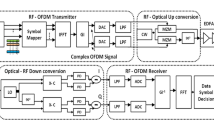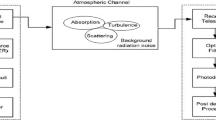Abstract
Free space optical communication (FSO) is a promising technology where optical fiber installation is not feasible. Performance of FSO system is affected by atmospheric attenuation caused by changing weather condition, such as haze, fog, snow, rain, etc., and scintillation induced by atmospheric turbulence. This article demonstrated the performance of coherent optical orthogonal frequency division multiplexing FSO (CO-OFDM FSO) system under the atmospheric turbulences and haze weather condition which performs better than traditional direct detection system. System is analyzed for different number of subcarriers under the influence of moderate to strong turbulence by adjusting the value of refractive index structure parameter. There is a degradation of 2–8 dB in SNR from moderate to strong turbulence up to the range of 30 km.
Access provided by CONRICYT-eBooks. Download conference paper PDF
Similar content being viewed by others
Keywords
1 Introduction
Free space optical communication (FSO) is being studied as suitable alternate for optical fiber communication especially due to its ease of deployment where fiber installation is not feasible. Recently, it is an active area of research due to its advantages like high transmission rates, license-free operation, full duplex system, and high transmission security [1, 2]. However, the turbulences and attenuations generated in the atmosphere seriously affect the accuracy of the optical signal when transmitted over atmospheric channel.
OFDM can not only effectively suppress the inter symbol interference (ISI) but also provide high data rates. This communication technique has robustness against frequency selective fading and better utilization of frequency spectrum [3, 4]. OFDM is considered as exclusive case of multi carrier modulation (MCM) scheme, where information signal is modulated onto subcarriers appearing in different frequencies. These subcarriers are orthogonal to each other and thus do not interfere with each other [5, 6]. Coherent optical OFDM (CO-OFDM) produces the better receiver sensitivity and spectral efficiency by using the local oscillator with photodetection system. The incoming signal is optically mixed with optical field of local oscillator, can track the phase and amplitude of the original transmitted signal [7, 8].
The outdoor system performance of the FSO depends upon the climatic conditions and transmission path, i.e., scintillation effects and atmospheric attenuation. Scintillation causes the fluctuations in the irradiance of received signal due to change in the refractive index of the air. Many statistical distributions have been studied to model these fluctuations [9–11]. In this research article, we have demonstrated the performance of coherent optical orthogonal frequency division multiplexing FSO (CO-OFDM-FSO) system under the effect of scintillation by varying channel’s refractive index structure parameter for different link lengths at haze weather condition. Moderate to strong turbulence is considered; SNR and received powers are analyzed over different link lengths. Rest of the article is organized as follows: in Sect. 2 a brief description of the simulative setup is provided, Sect. 3 presents the results and discussion and then Sect. 4 outlines conclusion.
2 Model Description
The FSO system is composed of three major communication parts that are transmitter, receiver, and propagation channel. The proposed CO-OFDM FSO system is designed using OPTISYSTEM v12 software generated 10 Gbps data rate. Data is generated by using 4-level QAM sequence generator with 2 bits per symbol. This QAM data is then modulates by using OFDM modulator with different number of subcarriers, i.e., 128, 512 and FFT size of 256 and 1024, respectively.
Sometimes subcarriers may lose their orthogonality and results in inter carrier interference (ICI), to over this effect cyclic prefix of 32 points is added [12, 13]. These OFDM analog signals are then optically modulated with light carrier generated by CW laser of –4 dBm power and wavelength of 1550 nm by means of two Mach--Zehnder modulators (MZM) to convert electrical signal to optical. Optical signal generated by MZM is transmitted through FSO channel having moderate and strong turbulences characterized by the value of refractive index structure parameter that is responsible for the scintillation effect. At the receiver base station signal is received by two PIN photodetectors derived by a local oscillator having same wavelength as that of transmitter is used to realize the coherent detection. After that OFDM demodulator and QAM decoder is used to decode the signal into its original form. To visualize the constellation diagram an electrical constellation visualizer is attached after OFDM demodulator. A BER test set is connected after QAM decoder having inbuilt pseudo random bit sequence (PRBS) generator used to generate the random data bits. Figure 1 shows the OPTISYSTEM layout of the system.
3 Results and Discussion
The results are conferred in this section characterized the total received power and SNR at moderate and strong turbulences under haze weather condition. Comparison of number of subcarriers at moderate and strong turbulences is done. Parameter values for the analysis are shown [14] (Table 1):
It has been shown in Fig. 2 that SNR for first 15 km has very small variation from moderate to strong turbulences. After that moderate turbulence has better SNR than strong turbulence, there is 2–8 dB deterioration in SNR from moderate to strong turbulence. As we increase the number of subcarriers there is an improvement of 6 dB in SNR.
Figure 3 shows the total power at different link lengths and reduction in power from moderate to strong turbulence. Table 2 illustrates the values for SNR and total power for different ranges under different turbulences. RF power decreases as we are increasing the link range. It is depicted from the Table 2 that system performs better when number of subcarriers is increased from 128 to 512.
At moderate turbulence value of SNR for subcarriers [512, 128] is [48.19, 42.78] and for strong turbulence values are [40.71, 35.02], respectively at 30 km range. These are acceptable values for SNR for successful transmission.
Electrical constellation diagram for FSO link after 20 km is shown in Fig. 4.
Constellation diagram in Fig. 4 shows the noise present in signal, it is observed that large amount of noise is present when subcarriers are 128 and can be reduced by increasing the number of subcarriers to 512. Results of coherent detection system that are shown above are better in terms of SNR and received power as compared of direct detection system demonstrated in [14].
4 Conclusion
In this work, we combine the advantages of coherent detection and OFDM technology in conventional FSO system and provide the data rate of 10 Gbps up to 30 km under the influence of turbulence in atmospheric channel and haze weather condition. From our simulation results, it is concluded that there is an improvement of 6 dB in SNR when we increase the number of subcarriers. As we increase the turbulence from moderate to strong there is degradation in the received power and SNR of the system. Proposed coherent system provides the better receiver sensitivity and SNR as compared to direct detection system.
References
V.W.S., Chan: Free-space optical communications. J. Lightwave Technol, vol. 24, no. 12, Dec (2006) 4750–4762
H., Willebrand, B., Ghuman: Free Space Optics: Enabling Optical Connectivity in Today’s Networks. London, U.K.: Sams (2002)
F., Buchali, R., Dischler, X., Liu: Optical OFDM: A Promising High-speed Optical Transport Technology. Bell Labs Technical Journal 14(1), (2009) 125–146
S., Attri, C., Narula, S., Kumar: Techniques to Mitigate Fading Effect in FSO using OFDM. Proceedings of 2015 RAECS, IEEE, (2015)
F.B., Frederiksen, R., Prasad: An overview of OFDM and Related Techniques Towards Development of Future Wireless Multimedia Communications. Radio and Wireless conference, IEEE, (2002) 19–22
Bahai, B.R., Saltzberg: Multi-carrier Digital Communication: Theory and Applications of OFDM. 2nd ed., Springer-Verlag, New York (2004)
V., Sharma, Sushank: High speed CO-OFDM-FSO transmission system. Optik, vol.125, no. 6, Mar (2014) 1761–1763
W., Shich, C., Athaudage: Coherent optical orthogonal frequency division multiplexing. Electron. Lett., vol. 40, no. 10, May (2006) 587–588
Y., Wang, D., Wang, J., Ma: On the Performance of Coherent OFDM Systems in Free-Space Optical Communications. IEEE Photonic Journal, Vol. 7, no. 4, Aug (2015) Art ID 7902410
H.E., Nistazakis, A.N., Stassinakis, H.G., Sandalidis, G.S., Tombras: QAM and PSK OFDM RoFSO over M-turbulence induced fading channels. IEEE Photonic journal, vol. 7, no. 1, Feb (2015) Art ID. 7900411
A., Bekkali, C., Ben Naila: Transmission analysis of OFDM-based wireless services over turbulent radio-on-FSO links modeled by gamma–gamma distribution. IEEE Photonic Journal, vol. 2, no. 3, May (2010) 510–520
S., Choudhary, A., Amphawan, K., Nisar: “Realization of free space optics with OFDM under atmospheric turbulence”, Elsevier Optic 125 (2014) 5196–5198
P., Patel, V., Mishra, V., Singh: Performance analysis of CO-OFDM FSO system under different weather conditions. 2nd International conference on emerging trends in Electronics, Communication and Networking, IEEE (2014) 1–5
P., Kumar, A., Srivastava: Enhanced Performance of FSO Link Using OFDM and Comparison with Traditional TDM-FSO Link. International Broadband and Photonics Conference, Bali, April (2015) 23–25
Acknowledgments
The authors would like to acknowledge the support by UIET, Panjab University. They wish to thank the Electronics and Communication department for providing the lab facilities and required software.
Author information
Authors and Affiliations
Corresponding author
Editor information
Editors and Affiliations
Rights and permissions
Copyright information
© 2017 Springer Science+Business Media Singapore
About this paper
Cite this paper
Saruchi Attri, Charu Narula, Sanjiv Kumar (2017). Performance Analysis of FSO Link Using CO-OFDM Under the Effect of Atmospheric Turbulence. In: Singh, R., Choudhury, S. (eds) Proceeding of International Conference on Intelligent Communication, Control and Devices . Advances in Intelligent Systems and Computing, vol 479. Springer, Singapore. https://doi.org/10.1007/978-981-10-1708-7_18
Download citation
DOI: https://doi.org/10.1007/978-981-10-1708-7_18
Published:
Publisher Name: Springer, Singapore
Print ISBN: 978-981-10-1707-0
Online ISBN: 978-981-10-1708-7
eBook Packages: EngineeringEngineering (R0)








